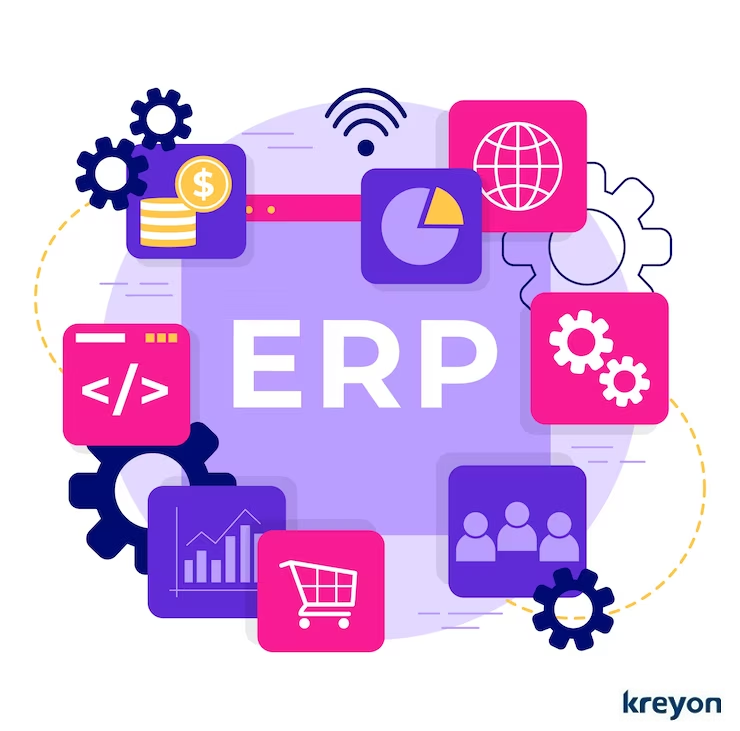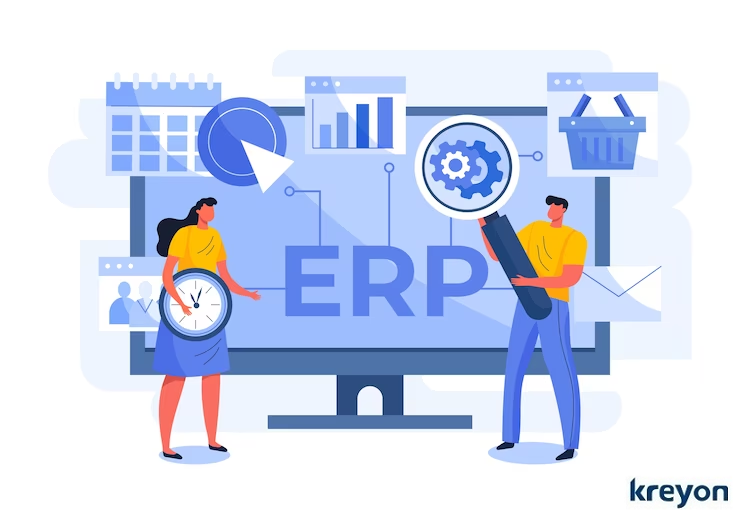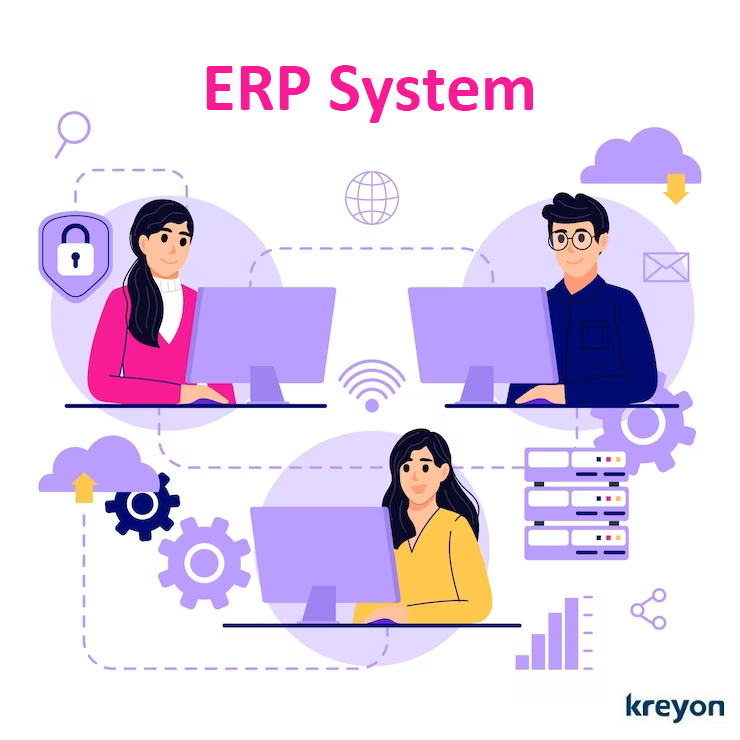Customized ERP System: Top ERP Implementation Challenges & Solutions for them

In today’s fast-paced business world, staying competitive, agile and adaptive is essential for long-term success. Customized ERP system (Enterprise Resource Planning) offers a potent solution for businesses to streamline operations, enhance productivity, and gain a competitive edge.
By tailoring ERP solutions to meet specific business needs, organizations can optimize processes and drive growth. However, implementing a customized ERP system comes with its share of challenges. In this comprehensive blog post, we will explore the top 7 challenges faced while implementing a customized ERP system and provide effective solutions to navigate and overcome them.
Complexity in Requirement Gathering
Challenge: One of the primary challenges of implementing a customized ERP system is the complexity in gathering and defining detailed requirements on what needs to be done.
Businesses have diverse needs and processes across departments, which can make requirement gathering a daunting task.
Solution: To overcome this challenge, start with a comprehensive analysis of existing workflows and processes. Engage in open communication with all key stakeholders, including department heads, users, and IT experts.
Conduct workshops, surveys, and interviews to identify pain points and specific business needs. Documentation is critical at this stage to ensure a clear and precise understanding of requirements and to avoid misunderstandings during the development phase.
Scope Creep and Change Management
Challenge: During the ERP development process, the scope may expand due to new requests or changing business requirements, leading to scope creep & potential delays.
Solution: The key to handling scope creep lies in effective change management. Implement a robust change management process to evaluate and prioritize new requirements.
Collaborate with stakeholders to assess the impact of changes on project timelines and budgets. It’s important to strike a balance between accommodating essential modifications and maintaining project schedules.
Clearly communicate any changes to all stakeholders, ensuring transparency and alignment throughout the development process. Additional work has invariable impact on deadlines, budget and schedule. A phased approach and sticking to project milestones and priorities is a must.
Integration with Existing Systems

Challenge: Integrating a customized ERP with existing legacy systems can be challenging, particularly when data structures and formats differ.
Solution: Prioritize seamless data integration to ensure a unified and efficient ERP system. Conduct a thorough data mapping exercise to identify data inconsistencies and potential conflicts.
Utilize middleware and integration tools to ensure smooth data exchange between the ERP system and existing applications. Conduct thorough testing to validate data integrity after integration.
By investing time and effort in seamless integration, businesses can achieve data accuracy and drive operational efficiency. For the system to be fully functional, integration often needs historical data and archives.
The responsibility for providing the data should be clearly established, data formats, and timelines mapped out in advance to avoid last minute surprises.
User Adoption and Training
Challenge: Employees may resist the adoption of a new ERP system due to unfamiliarity or concerns about its impact on their daily routines.
Solution: User adoption is crucial to the success of any ERP implementation. Implement a comprehensive user training program that covers all aspects of the customized ERP system.
Provide hands-on training and support for users to acclimate to the new system. Engage in regular feedback sessions and address user concerns promptly to foster confidence and acceptance. The ERP screens and workflow designs can be shared during early stages of implementation for feedback.
It’s also essential to emphasize the benefits of the ERP system, highlighting how it simplifies processes, saves time, and enhances productivity. Engaging employees throughout the implementation process can cultivate a positive attitude towards the new system.
Data Security and Privacy Concerns

Challenge: Customized ERP systems may handle sensitive business and customer data, raising concerns about data security and privacy.
Solution: Data security and privacy are paramount in any ERP implementation. Implement robust security measures, such as encryption, access controls, and multi-factor authentication, to protect data from unauthorized access.
Comply with industry regulations and best practices for data privacy, such as GDPR or HIPAA, depending on the nature of your business.
Conduct regular security audits and vulnerability assessments to identify potential weaknesses and address them promptly. Building a culture of data security awareness among employees is crucial to safeguarding sensitive information.
Vendor Support and Maintenance
Challenge: Post-implementation, businesses require ongoing vendor support and maintenance to address issues and implement updates.
Solution: Selecting the right ERP vendor is critical for long-term success. Choose a reputable ERP vendor with a strong track record of providing excellent support and timely updates. Negotiate a comprehensive support agreement that aligns with your organization’s requirements.
Regularly communicate with the vendor to stay informed about updates, new features, and improvements. Consider the vendor’s responsiveness and willingness to collaborate when choosing a long-term partner for ERP support and maintenance.
When choosing the ERP vendor, responsibilities and accountability must be clearly established. For e.g. Go-live support for the ERP should specify the hand off responsibilities of the vendor as well as the company.
Budget and Resource Management

Challenge: Implementing a customized ERP system requires significant investment in terms of finances, time, and resources.
Solution: Careful budget planning and resource management are essential to avoid cost overruns and delays. Create a detailed project plan with realistic timelines and milestones. Allocate resources strategically and consider any additional training requirements for employees involved in the ERP implementation.
Regularly monitor the project’s progress and expenditures to stay on track. Agile project management methodologies can help adapt to changing requirements and minimize disruptions during the development process.
Additional work, especially things that don’t add to the core value of the system must be avoided. It can lead to budget, resource and time overruns. Successful ERP implementation is often done in phases, organizational priorities dictate the ERP workflow and execution plan.
Conclusion
Implementing a customized ERP system is a transformative journey for businesses seeking to optimize operations, enhance productivity, and drive growth.
By navigating the top challenges – complexity in requirement gathering, scope creep, integration with existing systems, user adoption and training, data security and privacy concerns, vendor support and maintenance, and budget and resource management – businesses can ensure a successful ERP implementation.
With careful planning, effective change management, and collaborative efforts among stakeholders, a customized ERP system becomes a powerful tool for businesses to gain a competitive advantage in the ever-evolving business landscape.
Kreyon Systems develops customized ERP system for government and enterprise clients across several industries. If you have any questions for us, please get in touch with us.
